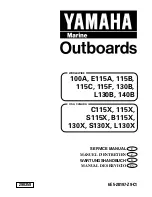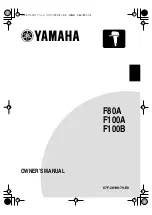
2-14
BF135A•BF150A
9. TROUBLESHOOTING
a. ENGINE
• HARD STARTING
• Use a known-good battery for troubleshooting.
Does not come ON.
Does not sound.
Comes ON.
Sounds.
Turn the ignition switch ON. Check whether
the MIL comes ON for 2 seconds.
Check whether the warning buzzer sounds
twice.
Does not turn.
Turns.
Fuel level OK.
Fuel flows freely.
Normal.
Check whether the starter motor turns.
Perform ignition (power) system trouble-
shooting (P. 2-20).
Perform warning system troubleshooting if the
warning buzzer sounds twice but keeps
sounding (intermittent sound).
Perform starting system troubleshooting (P. 2-
23).
No fuel or low level.
Add fuel and restart the engine.
Check the fuel level in the fuel tank.
Abnormal.
Perform fuel supply system troubleshooting
(P. 5-96).
Low compression.
Perform the following checks and adjust-
ments.
• Check valve clearance(P. 3-9)
• Check valve timing (P. 9-12)
• Check for loose cylinder head
• Check for damaged cylinder head gasket,
valves and valve seats.
• Check for worn pistons, piston rings and
cylinders.
Remove the spark plugs and check for wet
fouled electrodes.
Does not start.
Compression OK.
Perform ignition system troubleshooting (P.
2-25).
Fuel flow restricted.
• When gasoline overflow from the vapor sep-
arator is detected, check the vapor separa-
tor (P. 5-111 thru. 120).
Perform the following checks.
• Check for collapsed or pinched fuel line.
• Check whether the air vent knob of the tank
is closed.
• Check the primer bulb for air leakage.
• Squeeze the primer bulb and check whether
the fuel reaches the vapor separator.
If there is no problem, perform fuel supply sys-
tem troubleshooting (P. 5-96).
Remove the vapor separator drain screw
and check whether the fuel flows out freely.
Check whether the cylinder compression is
normal (P. 2-15).
Dry the spark plug electrodes and check
whether the engine starts.
















































